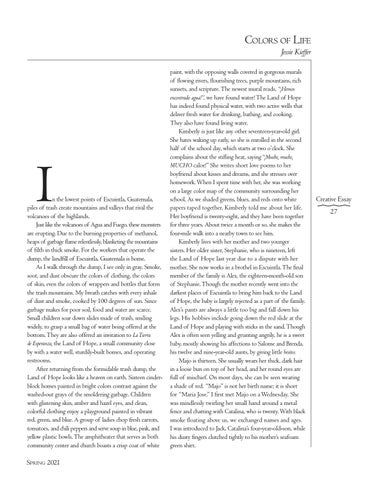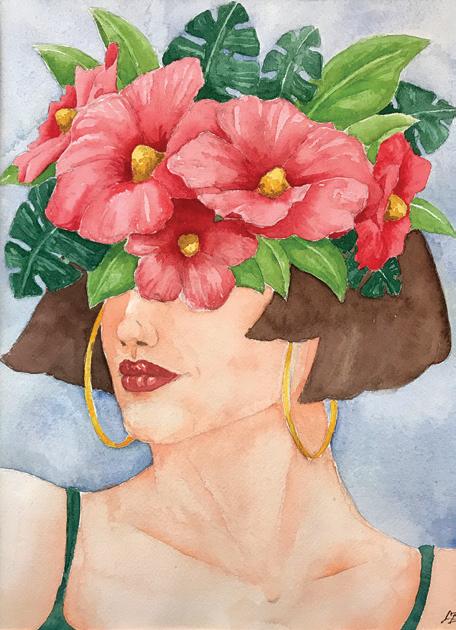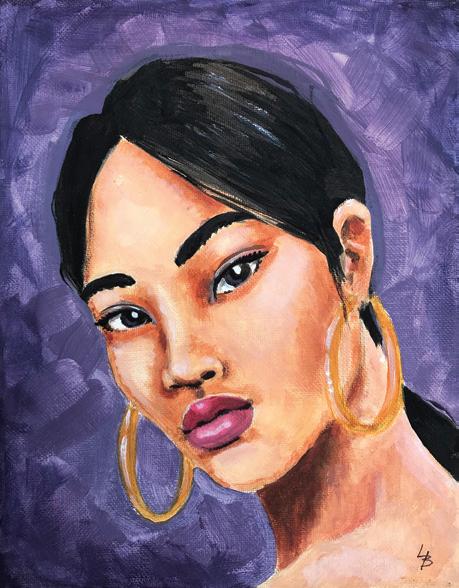Colors of Life Jessie Kieffer
I
n the lowest points of Escuintla, Guatemala, piles of trash create mountains and valleys that rival the volcanoes of the highlands. Just like the volcanoes of Agua and Fuego, these monsters are erupting. Due to the burning properties of methanol, heaps of garbage flame relentlessly, blanketing the mountains of filth in thick smoke. For the workers that operate the dump, the landfill of Escuintla, Guatemala is home. As I walk through the dump, I see only in gray. Smoke, soot, and dust obscure the colors of clothing, the colors of skin, even the colors of wrappers and bottles that form the trash mountains. My breath catches with every inhale of dust and smoke, cooked by 100 degrees of sun. Since garbage makes for poor soil, food and water are scarce. Small children soar down slides made of trash, smiling widely, to grasp a small bag of water being offered at the bottom. They are also offered an invitation to La Tierra de Esperanza, the Land of Hope, a small community close by with a water well, sturdily-built homes, and operating restrooms. After returning from the formidable trash dump, the Land of Hope looks like a heaven on earth. Sixteen cinderblock homes painted in bright colors contrast against the washed-out grays of the smoldering garbage. Children with glistening skin, amber and hazel eyes, and clean, colorful clothing enjoy a playground painted in vibrant red, green, and blue. A group of ladies chop fresh carrots, tomatoes, and chili peppers and serve soup in blue, pink, and yellow plastic bowls. The amphitheater that serves as both community center and church boasts a crisp coat of white
Spring 2021
paint, with the opposing walls covered in gorgeous murals of flowing rivers, flourishing trees, purple mountains, rich sunsets, and scripture. The newest mural reads, “¡Hemos encontrado agua!”, we have found water! The Land of Hope has indeed found physical water, with two active wells that deliver fresh water for drinking, bathing, and cooking. They also have found living water. Kimberly is just like any other seventeen-year-old girl. She hates waking up early, so she is enrolled in the second half of the school day, which starts at two o’clock. She complains about the stifling heat, saying “¡Mucho, mucho, MUCHO calor!” She writes short love poems to her boyfriend about kisses and dreams, and she stresses over homework. When I spent time with her, she was working on a large color map of the community surrounding her school. As we shaded greens, blues, and reds onto white papers taped together, Kimberly told me about her life. Her boyfriend is twenty-eight, and they have been together for three years. About twice a month or so, she makes the four-mile walk into a nearby town to see him. Kimberly lives with her mother and two younger sisters. Her older sister, Stephanie, who is nineteen, left the Land of Hope last year due to a dispute with her mother. She now works in a brothel in Escuintla. The final member of the family is Alex, the eighteen-month-old son of Stephanie. Though the mother recently went into the darkest places of Escuintla to bring him back to the Land of Hope, the baby is largely rejected as a part of the family. Alex’s pants are always a little too big and fall down his legs. His hobbies include going down the red slide at the Land of Hope and playing with sticks in the sand. Though Alex is often seen yelling and grunting angrily, he is a sweet baby, mostly showing his affections to Salome and Brenda, his twelve and nine-year-old aunts, by giving little besitos. Majo is thirteen. She usually wears her thick, dark hair in a loose bun on top of her head, and her round eyes are full of mischief. On most days, she can be seen wearing a shade of red. “Majo” is not her birth name; it is short for “Maria Jose.” I first met Majo on a Wednesday. She was mindlessly twirling her small hand around a metal fence and chatting with Catalina, who is twenty. With black smoke floating above us, we exchanged names and ages. I was introduced to Jack, Catalina’s four-year-old-son, while his dusty fingers clutched tightly to his mother’s seafoam green shirt.
Creative Essay 27



